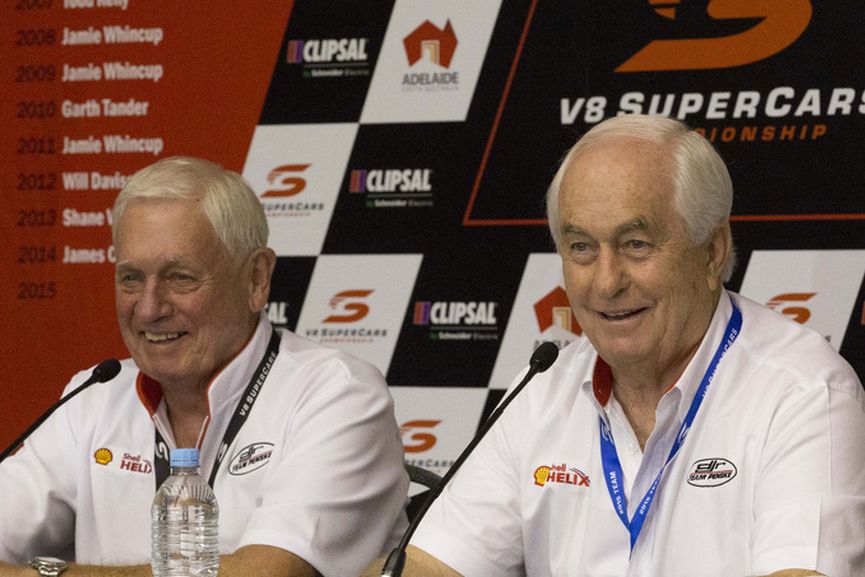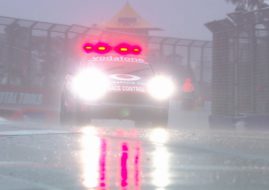DJR Team Penske - two legends under one roof
DJR Team Penske is the oldest racing team in the Australian V8 Supercars Championship. The team was founded in 1980 as Dick Johnson Racing by Dick Johnson. The team won seven drivers’ titles in the Australian Touring Car and V8 Supercars Championships, five times by Johnson himself and two more times by John Bowe and James Courtney. In 2014, another racing legend, American Roger Penske, joined the team as the major stakeholder, and the team was renamed to DJR Team Penske.

Penske Museum is a part of DJR Team Penske’s headquarte in Stayplton
Dick Johnson Racing was founded in 1980
During 1970s, Dick Johnson changed few teams but he was mostly driving for the Bryan Birt Racing team. When Byrt’s team folded at the end of the 1979 season, Johson utilised some resources and established his own team. Dick Johnson Racing was founded in 1980 and it was originally based out of Johnson’s home in Daisy Hill in Brisbane’s southern suburbs. Johnson was proud of his Queenslander origin and he frequently raced with state map on his car.
Over the years, team’s home location changed twice. The first time they moved to the factory of its sponsor Palmer Tube Mills and in the late 1990s, the new base became the workshop in Stayplton, where the team is still stationed.
The first car that Dick Johnson was driving in 1980 was Mazda RX-3, but only in one race and the brand new Ford XD Falcon came. Johnson competed in two races before he went to the 1980 Bathurst 1000, the race which was the one of the most remembered in the Australian motorsport history.
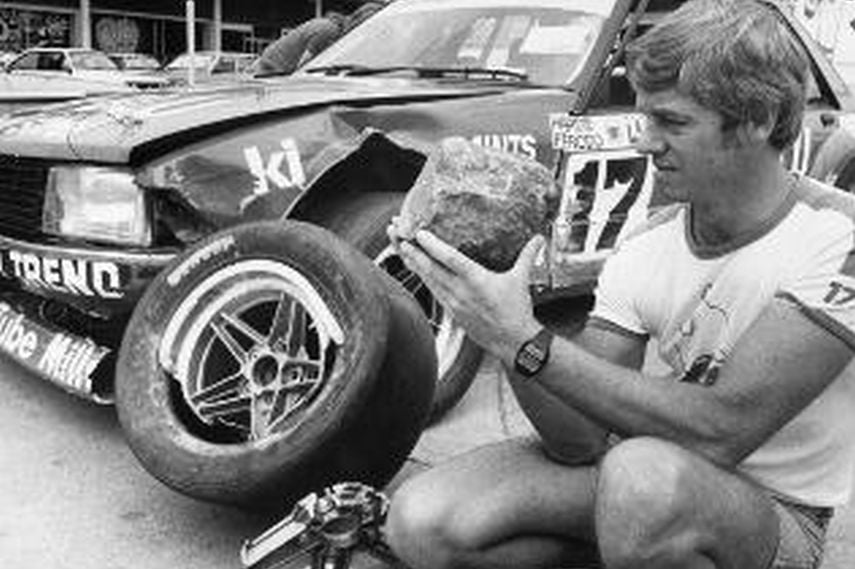
Dick Johnson with the infamous Bathurst rock
The infamous rock ruined Johnson’s efforts to win
Johnson qualified in the second place and started the race from the front row, with the biggest rival and eventual winner Peter Brock behind him. Johnson took the lead and maintained it for 17 laps. In that time there were no Safety Cars on the track, so on lap 17 the towing truck was carrying the broken car across the track, with other cars passing near. When Johnson came in full speed, he hit a large football-size rock, which was thrown on the track by some fans. Johnson’s Ford then hit the wall and was unable to continue the race.
Fans and Ford’s chief collected the money
During a Channel 7 television interview, Johnson stated that he spent all his finances for the race and that the crash would ruin his career. But, the Australian motorsport fans got together and decided to collect the money to put Johnson’s Ford back on track. Eventually, a total of AU$72,000 was raised. Edsel Ford II, the boss of Ford Australia, added $72,000 more. With $144,000 he got, Johnson rebuilt the car and returned to Bathurst in 1981.
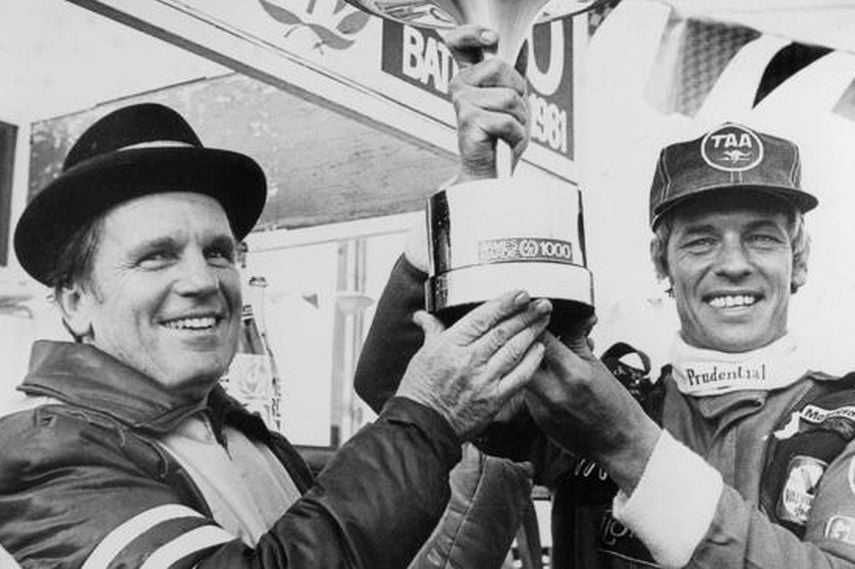
John French and Dick Johnson are celebrating victory at 1981 Bathurst race
1981 Bathurst victory with a rebuilt Falcon
Johnson and his co-driver John French won the race, which was stopped on Lap 122 laps after a multiple-car wreck blocked the track at McPhillamy Park Corner. It was Johnson’s first victory at the Mountain and the beginning of one of the greatest stories in Australian racing history.
Dick Johnson also won the 1981 Australian Touring Car Championship title, winning eight of 11 races. Peter Brock won three races and he battled against Johnson until the last race, at Dick’s home track at Lakeside. The two were fighting all the way to the chequered flag in what many believe to be one of the best ATCC races in history.
Two championship titles in a row
Johnson won the championship again in 1982, driving the #17 Falcon XD. He actually finished second in points behind Peter Brock, but Brock was disqualified for the use of yet to be homologated engine parts.
Johnson was disqualified at 1982 Bathurst 1000, after he finished 4th, because of illegal engine modifications on his brand-new Ford XE Falcon. In his biography, Johnson claims that the car was legal, but the team did not have the money to fight the ruling.
Johnson was first to carry Racecam
The 1982 Bathurst race became the milestone race in a history of Australian racing because it was the first time that Johnson’s car carried Channel 7’s Racecam unit, so the TV viewers had a live footage from inside the car. It made Johnson even more popular with the general public and motorsport fans, even with Holden fans.
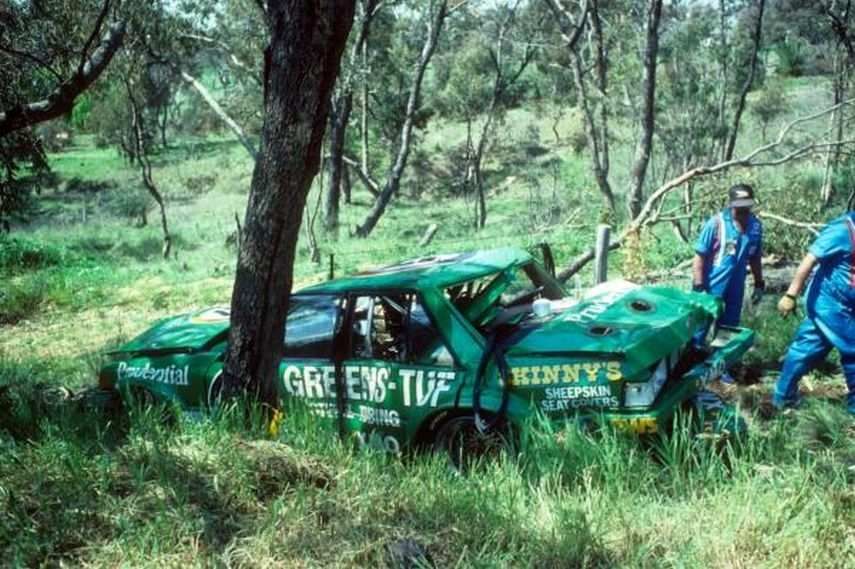
DJR’s Ford Falcon was destroyed at 1983 Bathurst race
One more major accident at Bathurst
In the 1983 Australian Touring Car Championship Johnson’s Falcon was not competitive against the Commodores, the Nissan Bluebird turbo or Allan Moffat‘s Mazda RX-7, which won the title. Johnson finished sixth in the standings with just two podiums in eight races.
At the 1983 Bathurst 1000, Johnson’s Falcon was one of the favourites. He set the second fastest time in the qualifying. During the Hardies Heroes Top 10 runoff on a Saturday morning, Johnson had a major accident. At Forrest’s Elbow, he went into trees and destroyed the car.
After the crash, fellow Falcon runner and reporter Andrew Harris offered his car to the Johnson’s team if a replacement car could be found for him. Johnson’s friend and sponsor Ross Palmer bought a replacement Holden for Harris and Johnson gets a Falcon. Unfortunately for Johnson and his new co-driver Kevin Bartlett, they raced for only 61 laps before being withdrawn with terminal electrical trouble.
Third championship title in 1984
Dick Johnson Racing was using a new XE Falcon in the 1984 Australian Touring Car Championship and he took his third championship title, after consistent run over the season and seven podiums in seven races, including a victory at Surfers Paradise. It was a final championship to be run under the locally developed Group C car rules. At 1984 Bathurst race Johnson and French didn’t reach the finish.
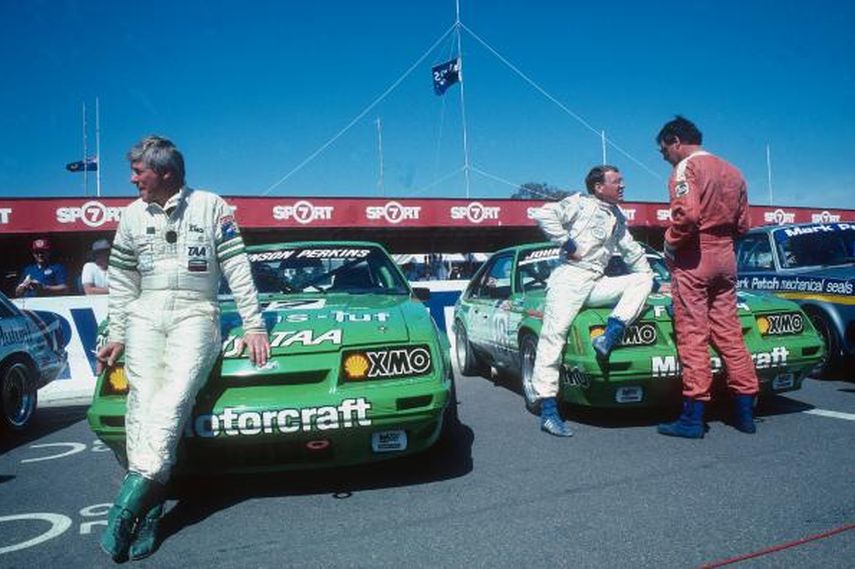
Jack Perkines joined Dick Johnson Racing in 1985 to drive endurance races
New Mustangs were outpaced by BMW
In 1985, the change to the international Group A rules followed and Johnson purchased a pair of Zakspeed constructed Ford Mustangs for the Australian championship. The car was outperformed by Jim Richard’s BMW 635 CSi, who won the title ahead of Johnson. Johnson’s only win was in the Group A support race of the F1 Australian Grand Prix.
For endurance races, Johnson signed triple Bathurst winner Larry Perkins to be his new co-driver. Against the Tom Walkinshaw Racing’s three V12 Jaguar XJSs, Johnson qualified fourth at Bathurst and ran strongly in the race until the cars oil cooler broke. Johnson and Perkins finished seventh. It’s interesting that the team entered two cars for the race, but #18 car Mustang was entered just as an insurance policy if something happened to the #17 Mustang. Ironically Johnson and Perkins qualified both cars for Hardies Heroes, but the #18 car was withdrawn before the race started.
Motorcycle ace partnered Johnson at Bathurst
With more competitive rival cars on the grid, Johnson could only finish sixth in the 1986 ATCC season with Mustang, with a best finish of 4th in the opening round at Amaroo Park.
For Sandown and Bathurst endurance races, the team signed former Grand Prix motorcycle star Gregg Hansford to be Johnson’s co-driver. Johnson qualified the car in sixth place and they finished fourth in the race. The last race for Mustang was the Group A support race at the 1986 Australian Grand Prix.
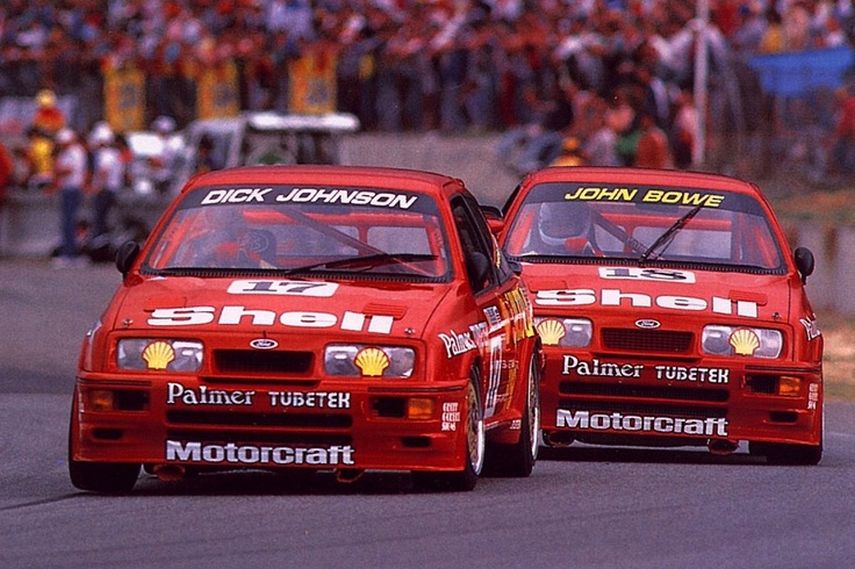
Dick Johnson Racing team was using the Ford Sierras since 1987
Two cars in the championship since 1987
In 1987, the team switched to the Ford Sierra RS Cosworth and began a sponsorship with Shell. The new turbocharged Sierra was unreliable and Johnson recorded only one victory in the 1987 Australian Touring Car Championship at the Adelaide International Raceway, finishing sixth in the final standings.
For the first time team had two cars in the championship. Gregg Hansford competed in the #18 car and finished tenth in the standings. Both cars retired at 1987 Bathurst. Johnson and Hansford were sharing the #17 car, the drivers in the second car were Charlie O’Brien and Neville Crichton. However, the year ended well with Johnson’s victory in the Group A support race at the Australian Grand Prix in November.
Ford Sierra RS500 was unbeatable beast
The new Ford Sierra RS500 was homologated for 1988. The car was more powerful than previous car (470 hp compared to 340 hp) and Dick Johnson Racing finally had a machine ready to win the championship. Not only that Johnson won the championship, but his new teammate John Bowe finished second in the final standings. Johnson took six wins in nine races, Bowe added two wins.
The team had three cars at 1988 Bathurst 1000 race, but just one finished the race. The #17 Sierra stopped after just 22 laps while #28 car lasted for 26 laps. Both Johnson and Bowe jumped into #18 car, sharing the car with John Smith, and they finished second, behind Tony Longhurst and Tomas Mezera.
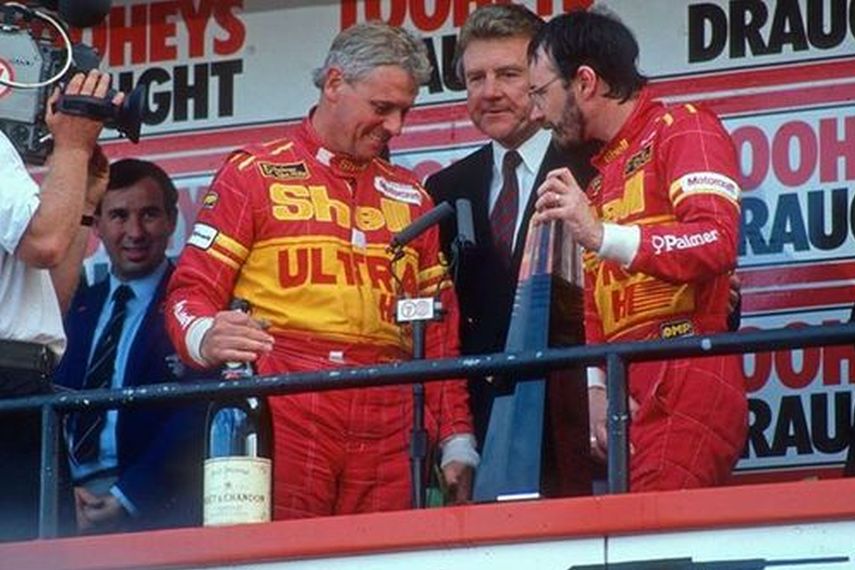
Dick Johnson and John Bowe – the winners of the 1989 Bathurst 1000
Johnson and Bowe again on the top in 1989
A year later, the #17 Ford Sierra RS500 was a winning car at 1989 Bathurst 1000 race, with Dick Johnson and John Bowe sharing the cockpit. Jeff Allam and Robb Gravett in the #18 car finished eighth.
In 1989 ATCC, Johnson and Bowe were again dominant in the championship and for the second year in a row they took first two places. Johnson won four of eight races, Bowe added two wins.
The early 1990s were tough times for DJR
In 1990, Johnson narrowly lost the title, finishing third behind Jim Richards and Peter Brock. John Bowe was fifth. At 1990 Bathurst Johnson and Bowe retired, but Jeff Allam and Paul Radisich in the #18 car took the second place.
In 1991, DJR drivers felt more down, Bowe finished seventh in the championship and Johnson was ninth. One more disappointing result followed at Bathurst, where both cars retired.
The 1992 season was a little bit better, with Bowe fourth in the championship and Johnson in 8th place. Bowe won three races and almost missed the win at Bathurst. The #17 crew Johnson/Bowe finished second behind Mark Skaife and Jim Richards in the Nissan Skyline R32 GT-R. The #18 car also finished the race, in eleventh place.

Ford Sierra was replaced with Ford EB Falcon in 1993
First Bathurst victory in the new V8 era
The support races of the 1992 Australian Grand Prix in Adelaide in November were the place where old Sierra met brand-new Falcon, prepared under the new V8 rules. Johnson debuted with new Ford EB Falcon to show the car, which was prepared for the next season. He started from the rear of the grid and progressed to 11th in the first race and 9th in the second race. John Bowe was driving Sierra RS500 and finished second in both races.
John Bowe won the opening round of the 1993 championship at Amaroo Park but it remained the only win for new Falcon. Bowe finished third in the standings, Johnson was two places behind him. At Bathurst Paul Radisich and Cameron McConville came to the finish eighth in the #18 car while Bowe and Johnson retired in the #17 Falcon.
They triumphed a year later, winning ahead of five Holdens. The #18 car, driven by Allan Grice and Dick’s son Steven, finished in 7th place. In the 1994 championship, the team expanded its efforts to three cars, with Steven Johnson in the third car.
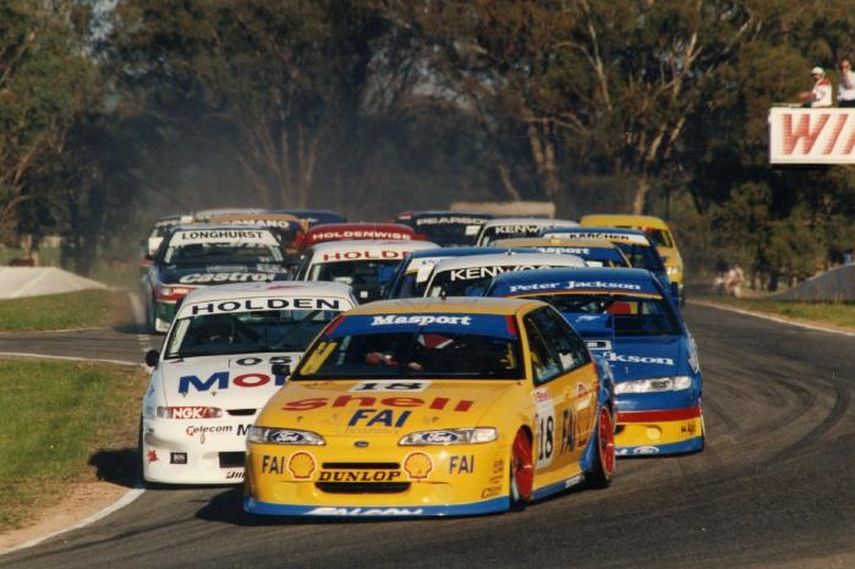
John Bowe was the 1995 Australian Touring Car champion with DJR’s Ford
John Bowe took the 1995 Australian championship title
The new Ford EF Falcon came in 1995 and John Bowe won the championship with it, after winning four of ten races. Dick Johnson finished seventh in the final classification. At 1995 Bathurst race, Steven Johnson and Charlie O’Brien finished seventh while #17 crew retired from the first place after an incident.
The 1996 season was marked by two second places. John Bowe was a runner-up in the championship and he took the second place at Bathurst, alongside Dick Johnson. Bowe repeated the championship result in 1997, finishing second behind Glenn Seton. The race at The Mountain finished with retirement. The #18 car was more successful, Steven Johnson and Craig Baird finished fourth at 1997 Bathurst.
Dick and Steven together in the #17 Falcon
At 1998, Bathurst John Bowe and Dick Johnson were separated for the first time because Dick was sharing the #17 car with his son Steven. Bowe shared the #18 car with Cameron McConville. Both cars retired early.
The 1998 ATCC season was the last for John Bowe in the team. He won one race at Winton and finished fifth in the championship. Bowe was replaced with Paul Radisich in 1999 while Dick Johnson announced that it was his last season.
The team struggled in the championship, which was renamed to the Shell Championship Series, with Dick Johnson in 10th place and Radisich in 16th. The highlight of the season was the Bathurst 1000 race, where Paul Radisich and Steve Ellery led for most of the race but retired after an accident 14 laps before the end. The Johnsons finished fourth in father’s last race.
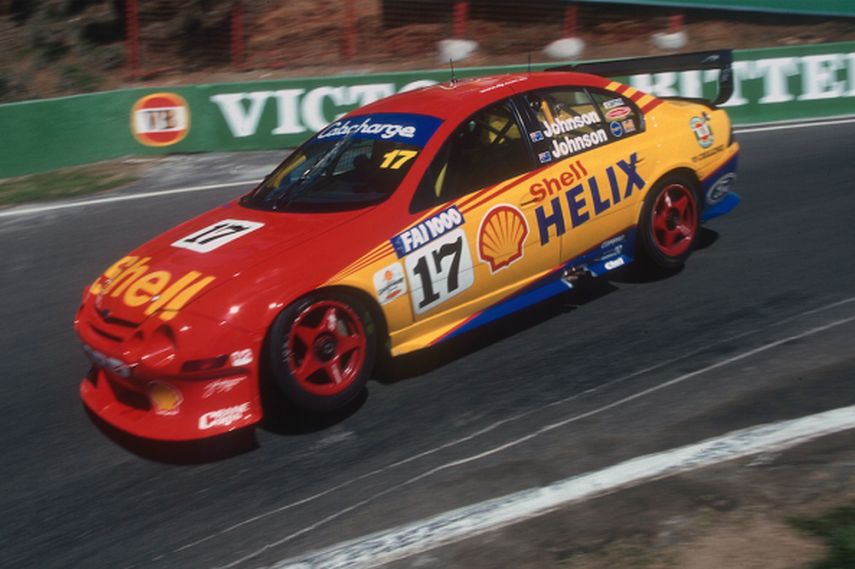
Johnson and Johnson scored fourth place in Dick’s last race at Bathurst
Steven Johnson took over father’s car
In 2000, Steven Johnson took over the #17 Falcon while Paul Radisich remained in the #18 car. Radisich finished fourth in the championship and took the second place at Bathurst, sharing the car with Jason Bright. Steven Johnson was also good and finished in fourth place.
In the 2001 Shell Championship Series, both Steven Johnson and Paul Radisich scored one victory each before they won together at Queensland 500. It remained the team’s last victory until 2008.
Seven years without victories
Steven Johnson was driving the #17 in the following years, while in the cockpit of the #18 car we some different faces. Radisich left at the end of 2002 season and he was replaced by Brazilian Max Wilson for 2003. In 2004, Warren Luff came to the team, but only for one season. Two-time champion Glenn Setton came in 2005, but also for just one season. From 2006, the new driver in the #18 car was Will Davison.
The 17-year long sponsorship with Shell came to the end in 2004, so for 2005 sponsorship from Westpoint Corporation was secured. It lasted just one season and for 2006 the sponsorship came from two of Dick Johnson’s companies – FirstRock Mortgage Centre and V8 Telecom. That didn’t solve the financial difficulties and at the end of the year businessman and sponsor, Charlie Schwerkolt bought a 50% shares of the team.
Will Davison brought DJR again to the top podium spot
The results get better and the team scored a podium at 2007 Bathurst 1000, with Steven Johnson and Will Davison in the #17 Falcon. In 2008, the first victory after seven-year drought came at Eastern Creek, when Will Davison won the race. Later in the season Steven Johnson also won a race at Hidden Valley Raceway. Davison finished fifth in the championship, Steven Johnson was eighth. Together they took sixth place at Bathurst.
In 2009, James Courtney came to the team, driving the #18 Ford FG Falcon and winning two races at Townsville and Sydney. He finished seventh in the championship, one place behind teammate Steven Johnson.
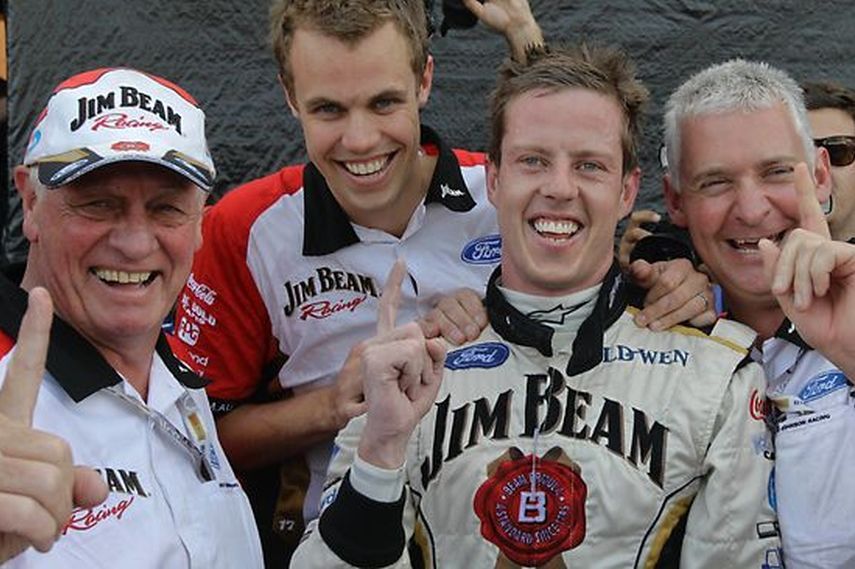
James Courtney brought the title to the team after 15 years of waiting
James Courtney – the last DJR’s V8 champion
In 2010, fifteen years after team’s last title, James Courtney won the championship. He triumphed in five races and won the title in a narrow finish against Jamie Whincup. Team manager Adrian Burgess announced he would leave at the end of the season. James Courtney had a clause in his contract which gives him a free hand if Burgess left, so Courtney also left the team after his victorious season. It was a really breaking year because Dick Johnson and Charlie Schwerkolt also dissolved their partnership.
The new teammate for Steven Johnson in 2011 was James Moffat.They stayed together in 2012, when the team expanded to four cars because they were preparing customer cars for Triple F Racing with Dean Fiore and Paul Morris Motorsport with Steve Owen.
Steven Johnson moved from cockpit to the office
In 2013, the last minute sponsorship from Wilson Security saved the team from financial problems. Steven Johnson moved from the cockpit to the position of the General Manager. The new driver of the #17 Falcon was Tim Blanchard. Jonny Reid was driving the #12 car in three round and then he was replaced by Chaz Mostert, who managed to win one race during the season.
For 2014 V8 Supercars Championship season the drivers line-up was all-new, with Scott Pye in the #16 car and David Wall in the #17 Falcon.
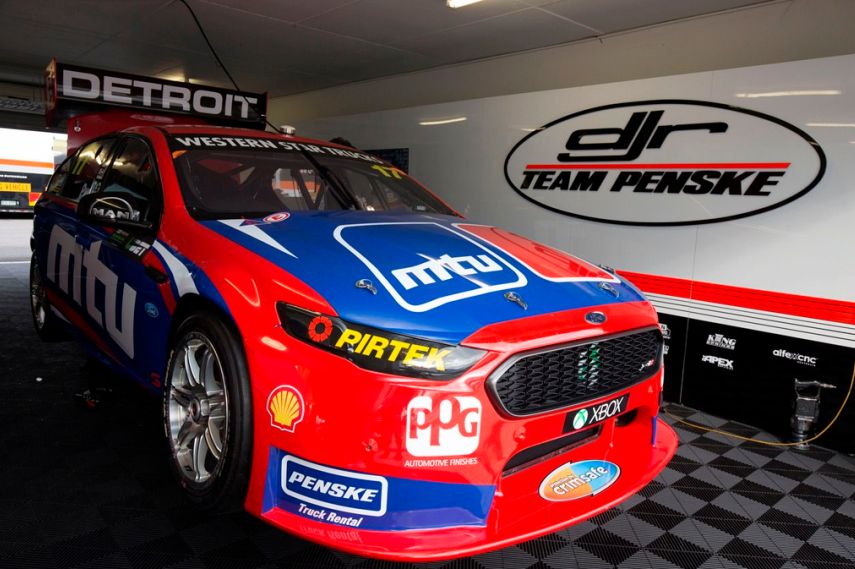
Roger Penske bougth a major stake part and renamed the team to DJR Team Penske
DJR Team Penske name since 2014
In September 2014, American racing legend and businessman Roger Penske, who already had few companies in Australia, stepped into Dick Johnson Racing as a new owner. He bought a 51% stake in the team. The remaining 49% is retained by Dick Johnson, Steve Brabeck and Ryan Story. The team was renamed to DJR Team Penske.
In 2015, the team competed with just one car, the #17 Ford FG X Falcon. Two-time V8 champion Marcos Ambrose returned from the United States and joined the team but after just one round he stepped aside and handed over the car to Scott Pye. Ambrose participated later in endurance races. The team scored just one podium when Pye finished third at Pukehoke Park Raceway.
For 2016, the team expanded to two cars, with Scott Pye in the #17 and newcomer Fabian Coulthard in the #12 Falcon.

DJR Team Penske 2016 drivers line-up: Scott Pye and Fabian Coulthard
Photos: djrteampenske.com.au, speedcafe.com, v8supercars.com.au,


